




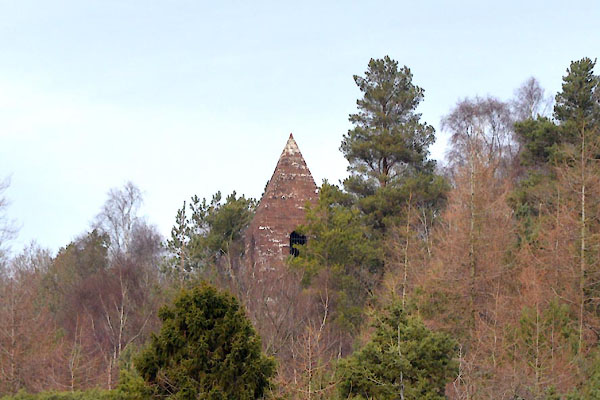
CHB41.jpg (taken 13.3.2018)
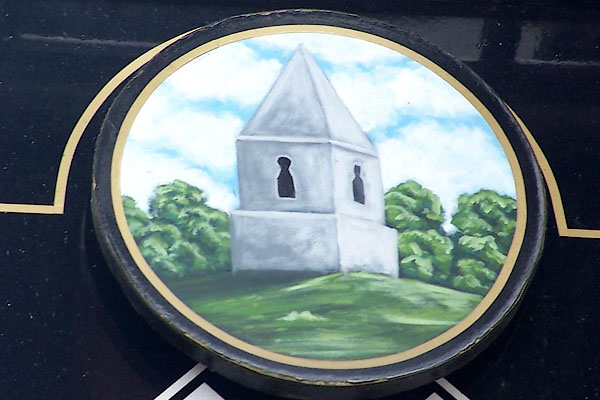
BMC43.jpg Depicted on the innsign of the Board and Elbow, Penrith.
(taken 12.5.2006)

Sax9NY53.jpg
Tower on hillock.
item:- private collection : 2
Image © see bottom of page
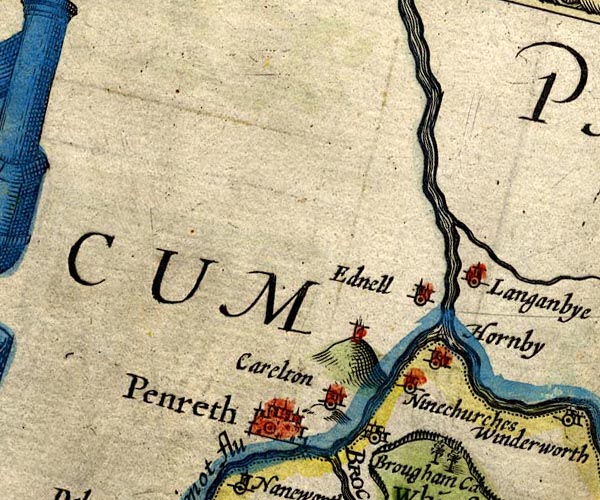
SP14NY53.jpg
tower on a hillock
item:- Armitt Library : 2008.14.5
Image © see bottom of page

MD12NY53.jpg
Small tower on a hillock.
item:- JandMN : 90
Image © see bottom of page
placename:- Penrith Beacon

MD10NY53.jpg
"Penrith Beacon"
On a hillock, post, ladder and cresset?.
item:- JandMN : 24
Image © see bottom of page
item:- rebellion, 1745; 1745 Rebellion
 goto source
goto sourceGentleman's Magazine 1746 p.62 "..."
"Dec. 14 [1745]. The D. of Perth with about 110 men, the vanguard of the rebels, ... intending for Penrith that night, but perceiving that beacon on fire, they enquir'd at a public house [in Eamont Bridge] the reason; the landlady told them it was to raise the country, and added, 'Gentlemen, I desire you for God's sake to go back, because all the hedges from here to Penrith are lin'd.' They follow'd her advice, and returned to Shap. ..."
item:- rebellion, 1745; 1745 Rebellion
 goto source
goto sourceGentleman's Magazine 1746 p.301 "... [1745 Rebellion]"
"Penrith beacon was fir'd as a signal of distress, and the whole country thereupon flock'd southward to its relief. A party of about 120 rebels, which had been driven from Kendal before the rest came up, were intercepted in their flight, and pursued into Orton craigs; ..."
placename:- Cumberland
"About a mile to the northward of Penrith, stands the Beacon, the fine prospects from which will amply repay the traveller the trouble of ascending it. It is a square stone building, and happily situated for alarming the country in times of public danger, as it commands an extensive vale. The northern window of the Beacon affords a prospect of Cross Fell, with the pikes of Dufton, together with a chain of mountains extending, from east to west, near thirty miles, the western point sinking in the spacious plain where the city of Carlisle lies. The utmost bounds of this view are formed by a ridge of Scotch mountains. The eastern window presents a view bounded by the hills of Stanmore, and that lofty promontory Wilbore Fell, with its neighbouring mountains above Kirby Stephen. The south window presents a view of Broughton Castle; and the spreading woods of Lowther, intermixed with rich cultivated lands, from the rising grounds. Some parts of the lake of"
MG02q012.txt
"Uls-water are seen from hence, while the mighty rocks and mountains which hem in the lake, lift up their heads in rude confusion, and crown the scene. The western window affords a new and not less pleasing prospect. The town of Penrith lies beneath it, and here and there the river Emont shows its windings through the woods. The hill, which rises above the town, is crowned with the aweful remains of a royal fortress: time has despoiled its grandeur, but its honours still survive to its noble owner the Duke of Portland, who therewith holds the honour of Penrith, formerly a royal franchise. Beyond these objects, amidst a range of mountains, at the distance of eighteen miles, Skiddow is seen, whose majestic front surmounts all the high lands that terminate the view. The whole prospect from the Beacon hill, as you turn every way, presents a vast theatre, upwards of one hundred miles in circumference, encircled with stupendous mountains."
placename:- Penrith Beacon
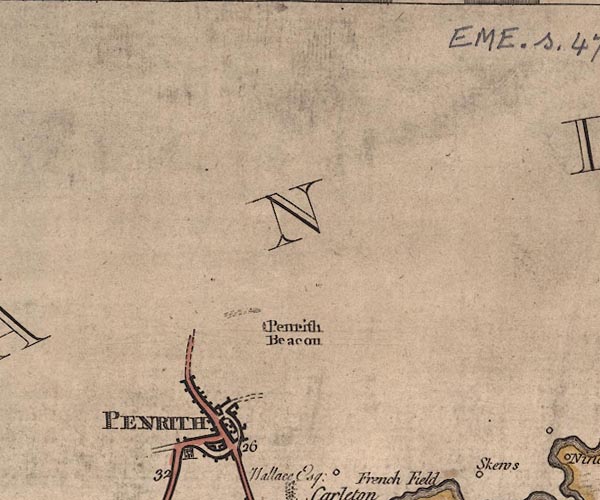
J5NY53SW.jpg
"Penrith Beacon"
tower
item:- National Library of Scotland : EME.s.47
Image © National Library of Scotland
placename:- Penrith Beacon

D4NY53SW.jpg
"Penrith Beacon"
tower
item:- Carlisle Library : Map 2
Image © Carlisle Library
item:- war; border reiver; outlaw
 goto source
goto sourcevol.2 p.85 "In the offskip, beyond the castle, arose a hill, in shadow likewise; on the top of which stood a lonely beacon. The windows answering each other, we could just discern the glowing horizon through them - a circumstance, which however trivial in description, has a beautiful effect in landscape."
"The beacon is a monument of those tumultuous times, which preceded the union; and the only monument of the kind now remaining in these parts; though such beacons were stationed over the whole country;"
 goto source
goto sourcevol.2 p.86 "and could spread intelligence, in a few seconds, from one end of it to the other."
"At this later day these castles and posts of alarm, adorning the country, they once defended, raise pleasing reflections on a comparison of present times with the past - those turbulent times, when no man could sleep in safety unless secured by a fortress. In war he feared the invasion of an open enemy: and in peace a mischief still more formidable, the ravages of banditti; with whom the country was always at that time infested. These wretches were composed of the outlaws from both nations; and inhabiting the fastnesses of the bogs, and mountains, used to sally out, and plunder in all directions."
"..."
 goto source
goto sourcePage 22:- "..."
"... this places [Bishop's Flatts] serves to stop, and breath a little, before we ascend the steep hill on which the beacon stands. The journey is laborious, though a fine green path renders it more pleasing; but when we arrive at the beacon, the beautiful and extensive prospect makes ample amends for all difficulties. If the day be clear, you see Cumberland spread like an immense map under you. Nor is your view limited to that alone, Criffell, Cheviot, and Queensbery-Hill in Scotland, are visible towards the N.E. though 80 miles distant. On the South, the mountains from Stainmoor in Westmorland, to Ingleborough in Yorkshire, rise in various tints of blue and purple. In the West, Helveylin and St Sunday's Cragg rear their rugged heads, whilst Ulswater is seen extended like an azure mirror at their feet; and towards the East, that immense ridge of mountains called Cross-Fell, extends itself no less than 30 miles in length; which, when covered with its Helm, exhibits a surprising and singular spectacle. From hence likewise may be distinctly seen, even with the naked eye, (provided the day be clear,) Carlisle, the white house at Gretna Green and Solway Firth; whilst all the nearer parts of the country offer themselves to the eye, so beautifully bespotted with villages, woods, heaths, forests, ruins, and elegant seats, that it must be seen, and not described, in order to convey away an idea of the grandeur of this prospect. To assist my reader as much as possible, I have, in the annexed Plate, drawn lines of direction to the several objects; let him therefore find one of them, (Ulswater, for instance,) and lay the Plan with the proper line of direction pointing to it; the Plan will then explain the country round, much better than the generality of guides will be able to do."
placename:- Penrith Beacon
item:- topograph
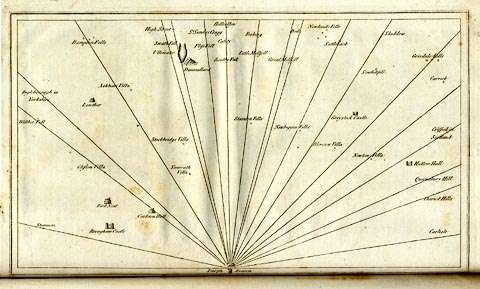 click to enlarge
click to enlargeCL18.jpg
"Penrith Beacon"
item:- Armitt Library : A6615.12
Image © see bottom of page
placename:- Penrith Beacon
item:- topograph
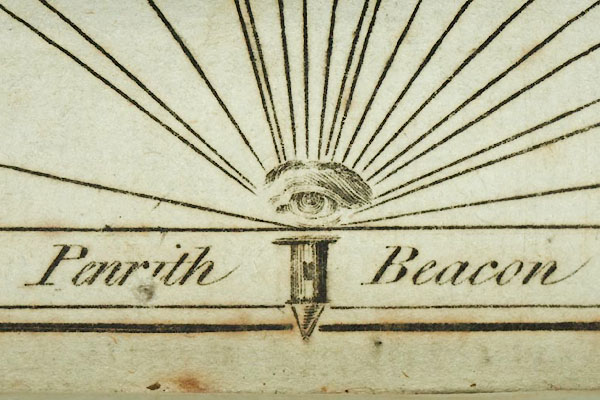
CL18Vgn1.jpg
"Penrith Beacon"
item:- Armitt Library : A6615.12
Image © see bottom of page
placename:- Beacon, The
pp.25-26:- "..."
"Penrith is situated beneath some verdurous heights that stretch from it towards the east; one point of which is decorated with a fancy building, commonly called the Beacon. From this spot is a most interesting view if the adjacent country, and hereon are the annual races of the town. ..."

Bk03Vg04.jpg
item:- private collection : 3
Image © see bottom of page
 goto source
goto sourcePage 83:- "... The Beacon, standing in the centre of a large plantation on Penrith fell, is a more modern erection of hewn stone, and commands extensive views of the country. ..."
placename:- Beacon, The
 goto source
goto sourcePage 132:- "..."
"... Above the race-course, on the point of a wood-embowered hill, stands the Beacon, which the traveller may visit for the purpose of seeing from a moderate elevation the country lying around, and thus forming a correct idea of the relative situation of places of interest. ..."
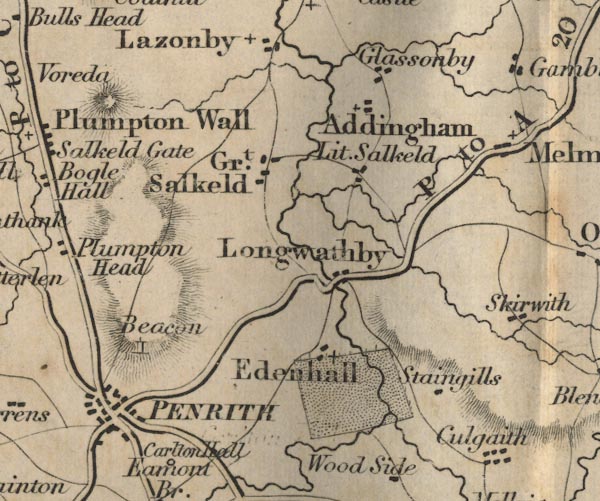
FD02NY53.jpg
"Beacon"
Tower, on the hill N of Penrith.
item:- JandMN : 100.1
Image © see bottom of page
placename:- Beacon Tower
courtesy of English Heritage
"BEACON TOWER / / BEACON ROAD / PENRITH / EDEN / CUMBRIA / I / 72779 / NY5212931377"
courtesy of English Heritage
"1719 on site of earlier beacons. Repaired 1780, red sandstone, low square tower with pyramid stone roof. Round-arched opening each side with keystones and wrought iron grilles, and small loops to north and south. Round-headed doorway on east. On top of hill, about 930 ft elevation, very prominent landmark."
placename:- Penrith Beacon
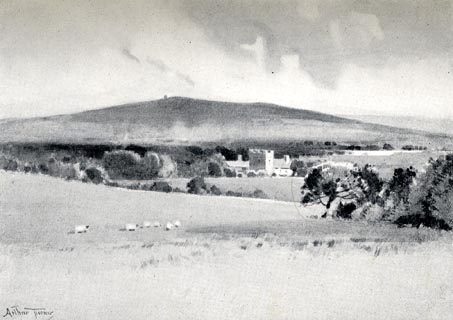 click to enlarge
click to enlargeRSN104.jpg
Tipped in opposite p.12 of Wordsworthshire by Eric Robertson.
printed at bottom:- "YANWATH, PENRITH, AND PENRITH BEACON / (seen from Sockbridge)"
signed at painting lower left:- "Arthur Tucker"
item:- JandMN : 197.4
Image © see bottom of page
